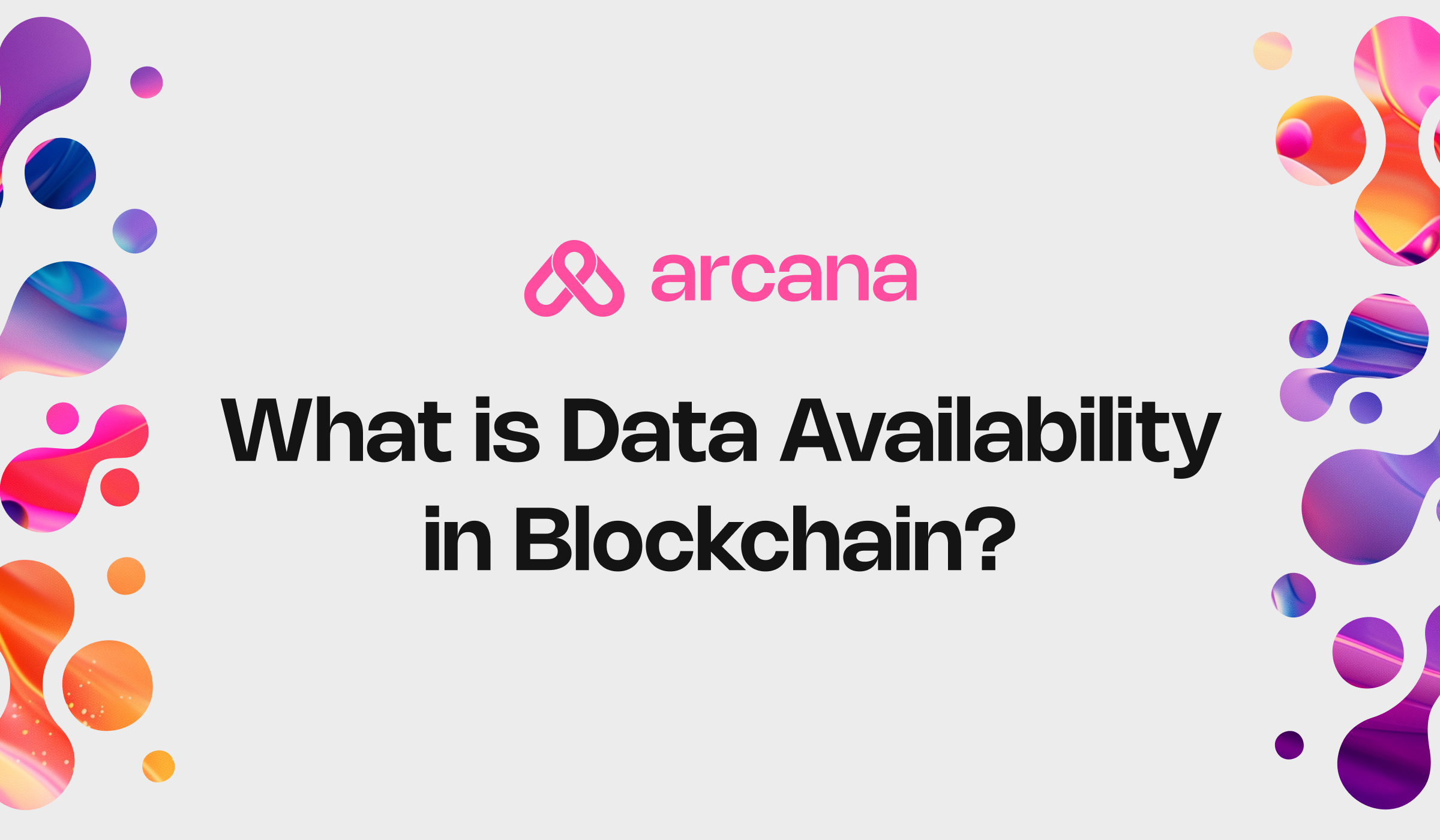What is Data Availability in Blockchain - A Primer

Imagine a world where information flows freely yet securely. This is the promise of blockchain technology. But as more people join this digital revolution, a challenge emerges: how do we ensure everyone has access to the data they need when they need it? Enter Data Availability (DA).
At its core, Data Availability (DA) ensures that all transaction data in a blockchain system is publicly accessible and verifiable by network participants. Theoretically, this is simpler to achieve with Layer 1 blockchains, where transaction data is posted directly to the blockchain. L1s face another set of challenges due to growing data volumes and resource requirements for full nodes. However, DA is more challenging for Layer 2 solutions, leading to specialized DA layers that help L2s maintain Data Availability. Without DA, the integrity of the entire system could be compromised.
Blockchains are facing a significant challenge. As more people use them, the volume of data is rapidly increasing. Traditional blockchains require every node to store, verify, and download all data, leading to slow transactions and high costs. This is where Data Availability (DA) steps in, playing a vital role in blockchain networks' security, scalability, and efficiency. DA ensures that transaction data is accessible for validation, enabling correct and timely processing while mitigating risks like data withholding.
How Does Data Availability Work?
DA solutions typically involve splitting data into smaller pieces and distributing them across the network. This distribution must allow for data reconstruction and verification without requiring every node to download the entire dataset.
- Sampling Techniques: One key method in DA is random sampling. Instead of verifying every piece of data, nodes can check random samples to ensure data availability with high probability. This is based on the principle that all data is likely available if a small random sample is available.
- How does it work?
- DA sampling involves randomly checking small data portions to ensure availability.
- By sampling a fraction of the total dataset, nodes can probabilistically verify that all data is accessible.
- This approach significantly reduces bandwidth and storage requirements while maintaining high confidence in data availability.
- How does it work?
For example, a node might request 10-20 random chunks of data from a block. If it receives all these chunks, it can be confident that the full data is available somewhere in the network. This drastically reduces the amount of data each node needs to process.
- Data Encoding Methods: Efficient data encoding is crucial for DA. One popular method is erasure coding. This technique adds redundancy to data, allowing the full dataset to be reconstructed even if some pieces are missing. Two widely used methods are:
- Erasure Coding (e.g., Reed-Solomon Encoding):
- Adds redundancy to data, enabling reconstruction even if some pieces are missing.
- For example, a dataset can be split into 100 pieces, where any 50 pieces are sufficient to reconstruct the original data.
- Merkle Trees:
- Cryptographically summarize large datasets, enabling efficient verification of specific data points without needing the entire dataset.
- Fraud Proofs: Fraud proofs are cryptographic proofs that act like receipts, verifying the correctness of data without needing to download and process the entire data set.
When a node suspects data might be incorrect, it can generate a fraud-proof, which is a compact, verifiable statement proving the issue. Other nodes can use this proof to confirm data integrity without downloading the entire dataset. While fraud proofs enhance efficiency, their effectiveness depends on honest participants actively monitoring and challenging incorrect data
Effective Data Availability solutions often combine sampling techniques, data encoding methods, and fraud proofs to create a robust system. Sampling provides a probabilistic guarantee of data availability. Erasure coding ensures data can be reconstructed even if parts are missing, and fraud proofs allow for efficient data integrity verification.
Types of DA Solutions
These solutions can be broadly categorized into on-chain, off-chain, and hybrid approaches, each with benefits and challenges. Layer 2 scaling solutions also leverage DA layers to enhance scalability. Let’s delve into these types of DA solutions:
- On-Chain Data Availability: On-chain DA solutions store all data directly on the blockchain. This approach ensures maximum security and decentralization, as all data recorded is immutable and available to all network participants. Key reasons to select on-chain DA:
- Security: Storing data on-chain ensures that it benefits from the blockchain’s inherent security features, including cryptographic hashing and consensus mechanisms.
- Transparency: Data stored on-chain is publicly accessible and verifiable, promoting trust and accountability.
- Storage Costs: On-chain storage can be expensive, as every node in the network must store a complete copy of the blockchain.
While on-chain DA ensures maximum security and decentralization, it often creates scalability challenges due to high resource requirements for storing and processing data on every node. Examples of blockchains using on-chain DA are BTC and ETH.
- Off-Chain Data Availability: Off-chain Data Availability involves storing data outside the blockchain, often in decentralized storage networks or other external systems. This approach reduces the load on the blockchain while still ensuring data accessibility and integrity. Key reasons to select Off-chain DA:
- Scalability: Off-chain solutions significantly reduce the amount of data that needs to be processed by the blockchain, enhancing scalability.
- Cost Efficiency: By storing data off-chain, networks can save on storage costs and reduce the burden on individual nodes.
- Security: Off-chain data must be secured and verified to prevent tampering or loss. This often requires additional cryptographic techniques and trust assumptions.
- Complexity: Managing data off-chain can introduce complexity, as it requires robust mechanisms for ensuring everything is working as usual.
Roll-ups and Validium are examples of solutions that use off-chain DA. They process transactions off-chain but differ in how they manage DA. Optimistic Roll-ups typically post minimal data on-chain for DA, while Validium relies on external sources for data availability, which can introduce different trust assumptions
- Hybrid Data Availability: Hybrid DA combines on-chain and off-chain approaches to balance security, scalability, and efficiency. Critical data is stored on-chain, while less critical or bulk data is stored off-chain.
The key pointers are a mix of the on-chain and off-chain DA discussed above. The only added disadvantage is the complexity of ensuring seamless coordination between on-chain and off-chain data, which can be complex and may require sophisticated protocols.
Real-World Use Cases of Data Availability
Let’s explore how DA is used in real-world use cases, including L2s, decentralized storage networks, cross-chain communication, and Chain Abstraction.
- Layer 2 Solutions: L2s use DA to increase transaction throughput. They aim to enhance the scalability of blockchain networks by processing transactions off-chain while maintaining the security and decentralization of the main chain. DA is crucial in ensuring that these off-chain transactions are accessible and verifiable. Here is how it is used in various scenarios
- Optimistic Rollups: These solutions aggregate multiple transactions into a batch processed off-chain. The summary data is submitted on-chain, and a challenge period is provided for anyone to submit fraud proofs if they detect incorrect data. DA ensures that the transaction data is accessible for verification during this period. For example, Optimism uses this approach to process thousands of transactions per second while relying on Ethereum for security.
- ZK-Rollups: Zero-Knowledge Rollups use cryptographic proofs to verify the validity of transactions off-chain. The proofs and a minimal amount of data are submitted on-chain. Solutions like zkSync use on-chain DA to post compressed transaction data alongside zero-knowledge proofs. This allows users to reconstruct the L2 state independently, enhancing security.
- State Channels: In state channels, participants transact off-chain and only submit the final state on-chain. DA ensures that the necessary data is available for participants to verify the final state, allowing them to trust the outcome without storing all transaction data on-chain.
- Data Storage Networks: Decentralized storage networks provide a way to store data in a distributed manner, leveraging the principles of blockchain technology. Decentralized storage networks like IPFS and Filecoin use DA techniques to manage and verify the availability of stored data.
- Cross-Chain Communication: Cross-chain communication enables different blockchain networks to interact and exchange data, enhancing interoperability. DA ensures that data exchanged between chains is available and verifiable. Cross-chain communication protocols use DA to manage data exchange between different blockchain networks.
Relays, atomic swaps, and Bridges are major stakeholders in any cross-chain communication and interaction. They rely on real-time data to execute the tasks at hand between chains. These tasks can be relaying or monitoring events on other blockchains, swapping different cryptocurrencies between chains, or bridging two blockchains.
DA ensures that the data required for these events is accessible and can be verified by the receiving chain. - Chain Abstraction: Built on top of Cross-chain communication, Chain abstraction is the ability to abstract away the complexities of interacting with multiple blockchain networks, providing a unified interface for developers and users. DA is crucial in maintaining the availability and integrity of data across these.
In all these cases, DA solutions are working behind the scenes to ensure that necessary data is available when and where it's needed. This enables these systems to operate securely and efficiently, often at scales far beyond what would be possible with traditional blockchain architectures.
DA is a cornerstone of modern blockchain architecture, from powering Layer 2 scaling solutions to enabling efficient cross-chain communication and decentralized storage networks. As blockchains evolve, robust DA systems will play a pivotal role in unlocking faster, interconnected, and globally viable decentralized networks, paving the way for blockchain's full potential.
Discover the Power of Chain Abstraction
Want to dive deeper into how chain abstraction can simplify your blockchain projects? Visit our Abstracted Academy and unlock the potential of seamless interoperability across chains.

